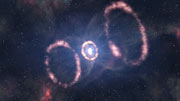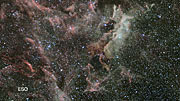Comunicato Stampa
Esplosione Stellare in 3D
04 Agosto 2010
Utilizzando il Very Large Telescope gli astronomi dell'ESO hanno ottenuto per la prima volta una visione tridimensionale di come si propaga il materiale più interno di una supernova durante la sua esplosione, avvenuta recentemente. L'esplosione iniziale non solo era potente ma, secondo i nuovi risultati, si concentrava in una direzione particolare. Ciò evidenzia la forte turbolenza caratterizzante la supernova, comprovando i modelli informatici più recenti.
A differenza del Sole, che morirà piuttosto tranquillamente, le stelle massicce che al termine della loro breve vita esplodeno come supernove, scagliando intorno a sé una quantità enorme di materiale. In questa classe la Supernova 1987A (SN 1987A), nella “vicina” Grande Nube di Magellano, occupa un posto molto speciale. Vista nel 1987, è stata la prima supernova visibile ad occhio nudo osservata da 383 anni (/ public/news/eso8704). La sua relativa vicinanza, ha reso possibile agli astronomi studiare l'esplosione di una stella massiccia e le sue conseguenze in modo più dettagliato rispetto al passato. Non è quindi una sorpresa che pochi eventi in astronomia moderna siano stati accolti con un tale entusiasmo da parte degli scienziati.
SN 1987A è stata una miniera d'oro per gli astrofisici (/ public/news/eso8711 e / public/news/eso0708). Esso ha permesso di ottenere alcuni importanti 'primati', come la rivelazione di neutrini prodotti dal collasso stellare nucleo interno che innesca l'esplosione, la localizzazione su lastre fotografiche d'archivio della stella prima che esplodesse, i segni di una esplosione asimmetrica, l'osservazione diretta degli elementi radioattivi prodotti durante l'esplosione, l'osservazione della formazione di polvere nel supernova, così come l'individuazione di materiale interstellare e circumstellare (/ public/news/eso0708).
Nuove osservazioni che hanno fatto uso di uno strumento unico, SINFONI [1], su dell'ESO Very Large Telescope (VLT) ha permesso di approfondire questo evento straordinario. Gli astronomi sono stati così in grado di ottenere, per la prima volta in 3D, la ricostruzione di come la parte centrale del materiale si è propagata nell’esplosione.
Questo ha permesso di provare come l’esplosione sia stata più forte e più veloce in alcune direzioni rispetto ad altre, producendo una forma irregolare con alcune parti più allungate nello spazio.
Questo primo materiale può essere espulso all’incredibile velocità di 100 milioni km/h, un decimo della velocità della luce o 100.000 volte più veloce di un aereo passeggeri. Nonostante questa folle velocità, ci sono voluti 10 anni per raggiungere l’anello preesistente di gas e polveri prodotti dalla stella morente. Le immagini mostrano inoltre una nuova ondata di materiale in viaggio dieci volte più lentamente, riscaldata dagli elementi radioattivi creati nell'esplosione.
"Abbiamo stabilito la distribuzione di velocità del getto proveniente dalla parte interna della supernova 1987A," dice l'autore Karina Kjær. "Ad oggi il meccanismo di esplosione supernova non è molto ben compreso, ma il modo in cui la stella esplosa è impressa in questo materiale interiore. Si può vedere che questo materiale non è stato espulso simmetricamente in tutte le direzioni, ma piuttosto sembra aver avuto una direzione preferita. Inoltre, questo orientamento è diverso da quanto ci si aspettava dalla posizione dell’anello. "
Tale comportamento asimmetrico era stato ipotizzato da alcuni dei modelli più recenti al computer sulle supernove, secondo i quali le instabilità su larga scala hanno luogo durante l'esplosione. Le nuove osservazioni sono quindi la prima conferma diretta di tali modelli.
SINFONI è uno strumento unico nel suo genere, e solo il livello di dettaglio che esso offre, ha permesso al team di trarre tali conclusioni. Avanzati sistemi di ottica adattiva contrastano gli effetti di sfocatura dovuto all’atmosfera terrestre, mentre una tecnica chiamata spettroscopia a campo integrale ha permesso agli astronomi di studiare diverse parti del centro caotico della supernova contemporaneamente, portando alla formazione di immagini 3D.
La spettroscopia a campo integrale è una speciale tecnica di spettroscopia dove per ogni pixel si ottengono informazioni sulla natura e la velocità del gas", dice Kjær. "Questo significa che oltre la visione generale abbiamo a disposizione anche la velocità lungo la linea di vista. Poiché sappiamo il tempo trascorso da quando vi è stata l'esplosione e poiché il materiale è in movimento verso l'esterno liberamente, siamo in grado di convertire questa velocità in distanza. Questo ci dà un quadro della getto interiore come se visto sia di dritto che di lato."
Note
[1] Il team ha usato SINFONI (Spectrograph for INtegral Field Observations in the Near Infrared) lo strumento montato sul Very Large Telescope (VLT). dell'ESO. SINFONI è uno spettrografo a campo integrale nel vicino infrarosso (1.1–2.45 µm) alimentato da un modulo di ottica adattiva.
Ulteriori Informazioni
Questa ricerca appare su Astronomy and Astrophysics (“The 3-D Structure of SN 1987A’s inner Ejecta”, by K. Kjær et al.).
Il team è composto da Karina Kjær (Queen’s University Belfast, UK), Bruno Leibundgut e Jason Spyromilio (ESO), e Claes Fransson e Anders Jerkstrand (Stockholm University, Sweden).
L’ESO (European Southern Observatory) è la principale organizzazione intergovernativa di Astronomia in Europa e l’osservatorio astronomico più produttivo al mondo. È sostenuto da 14 paesi: Austria, Belgio, Repubblica Ceca, Danimarca, Finlandia, Francia, Germania, Italia, Olanda, Portogallo, Spagna, Svezia, Svizzera e Gran Bretagna. L’ESO mette in atto un ambizioso programma che si concentra sulla progettazione, costruzione e gestione di potenti strutture astronomiche da terra che consentano agli astronomi di fare importanti scoperte scientifiche. L’ESO ha anche un ruolo preminente nel promuovere e organizzare cooperazione nella ricerca astronomica. L’ESO gestisce tre siti unici di livello mondiale in Cile: La Silla, Paranal e Chajnantor. A Paranal, l’ESO gestisce il Very Large Telescope, l’osservatorio astronomico nella banda visibile più d’avanguardia al mondo. L’ESO è il partner europeo di un telescopio astronomico rivoluzionario, ALMA, il più grande progetto astronomico esistente. L’ESO sta pianificando al momento la realizzazione di un gigantesco telescopio nell’ottico/vicino-infrarosso di 42 metri di diametro, lo European Extremely Large Telescope, E-ELT, che diventerà “il più grande occhio del mondo rivolto al cielo”.
Links
Contatti
Karina Kjær
Queen’s University
Belfast, UK
Tel.: +44 28 9028 8662
Cell.: +44 79 1608 0702
E-mail: karina.kjaer@gmail.com
Bruno Leibundgut
ESO
Garching bei München, Germany
Tel.: +49 89 3200 6295
E-mail: bleibund@eso.org
Richard Hook
ESO, La Silla, Paranal, E-ELT and Survey telescopes Press Officer
Garching bei München, Germany
Tel.: +49 89 3200 6655
E-mail: rhook@eso.org
Joerg Gasser (press contact Svizzera)
Rete di divulgazione scientifica dell'ESO
E-mail: eson-switzerland@eso.org
Sul Comunicato Stampa
| Comunicato Stampa N": | eso1032it-ch |
| Nome: | SN 1987A |
| Tipo: | Local Universe : Star : Evolutionary Stage : Supernova |
| Facility: | Very Large Telescope |
| Instruments: | SINFONI |
| Science data: | 2010A&A...517A..51K |
Our use of Cookies
We use cookies that are essential for accessing our websites and using our services. We also use cookies to analyse, measure and improve our websites’ performance, to enable content sharing via social media and to display media content hosted on third-party platforms.
ESO Cookies Policy
The European Organisation for Astronomical Research in the Southern Hemisphere (ESO) is the pre-eminent intergovernmental science and technology organisation in astronomy. It carries out an ambitious programme focused on the design, construction and operation of powerful ground-based observing facilities for astronomy.
This Cookies Policy is intended to provide clarity by outlining the cookies used on the ESO public websites, their functions, the options you have for controlling them, and the ways you can contact us for additional details.
What are cookies?
Cookies are small pieces of data stored on your device by websites you visit. They serve various purposes, such as remembering login credentials and preferences and enhance your browsing experience.
Categories of cookies we use
Essential cookies (always active): These cookies are strictly necessary for the proper functioning of our website. Without these cookies, the website cannot operate correctly, and certain services, such as logging in or accessing secure areas, may not be available; because they are essential for the website’s operation, they cannot be disabled.
Functional Cookies: These cookies enhance your browsing experience by enabling additional features and personalization, such as remembering your preferences and settings. While not strictly necessary for the website to function, they improve usability and convenience; these cookies are only placed if you provide your consent.
Analytics cookies: These cookies collect information about how visitors interact with our website, such as which pages are visited most often and how users navigate the site. This data helps us improve website performance, optimize content, and enhance the user experience; these cookies are only placed if you provide your consent. We use the following analytics cookies.
Matomo Cookies:
This website uses Matomo (formerly Piwik), an open source software which enables the statistical analysis of website visits. Matomo uses cookies (text files) which are saved on your computer and which allow us to analyze how you use our website. The website user information generated by the cookies will only be saved on the servers of our IT Department. We use this information to analyze www.eso.org visits and to prepare reports on website activities. These data will not be disclosed to third parties.
On behalf of ESO, Matomo will use this information for the purpose of evaluating your use of the website, compiling reports on website activity and providing other services relating to website activity and internet usage.
Matomo cookies settings:
Additional Third-party cookies on ESO websites: some of our pages display content from external providers, e.g. YouTube.
Such third-party services are outside of ESO control and may, at any time, change their terms of service, use of cookies, etc.
YouTube: Some videos on the ESO website are embedded from ESO’s official YouTube channel. We have enabled YouTube’s privacy-enhanced mode, meaning that no cookies are set unless the user actively clicks on the video to play it. Additionally, in this mode, YouTube does not store any personally identifiable cookie data for embedded video playbacks. For more details, please refer to YouTube’s embedding videos information page.
Cookies can also be classified based on the following elements.
Regarding the domain, there are:
- First-party cookies, set by the website you are currently visiting. They are stored by the same domain that you are browsing and are used to enhance your experience on that site;
- Third-party cookies, set by a domain other than the one you are currently visiting.
As for their duration, cookies can be:
- Browser-session cookies, which are deleted when the user closes the browser;
- Stored cookies, which stay on the user's device for a predetermined period of time.
How to manage cookies
Cookie settings: You can modify your cookie choices for the ESO webpages at any time by clicking on the link Cookie settings at the bottom of any page.
In your browser: If you wish to delete cookies or instruct your browser to delete or block cookies by default, please visit the help pages of your browser:
Please be aware that if you delete or decline cookies, certain functionalities of our website may be not be available and your browsing experience may be affected.
You can set most browsers to prevent any cookies being placed on your device, but you may then have to manually adjust some preferences every time you visit a site/page. And some services and functionalities may not work properly at all (e.g. profile logging-in, shop check out).
Updates to the ESO Cookies Policy
The ESO Cookies Policy may be subject to future updates, which will be made available on this page.
Additional information
For any queries related to cookies, please contact: pdprATesoDOTorg.
As ESO public webpages are managed by our Department of Communication, your questions will be dealt with the support of the said Department.



